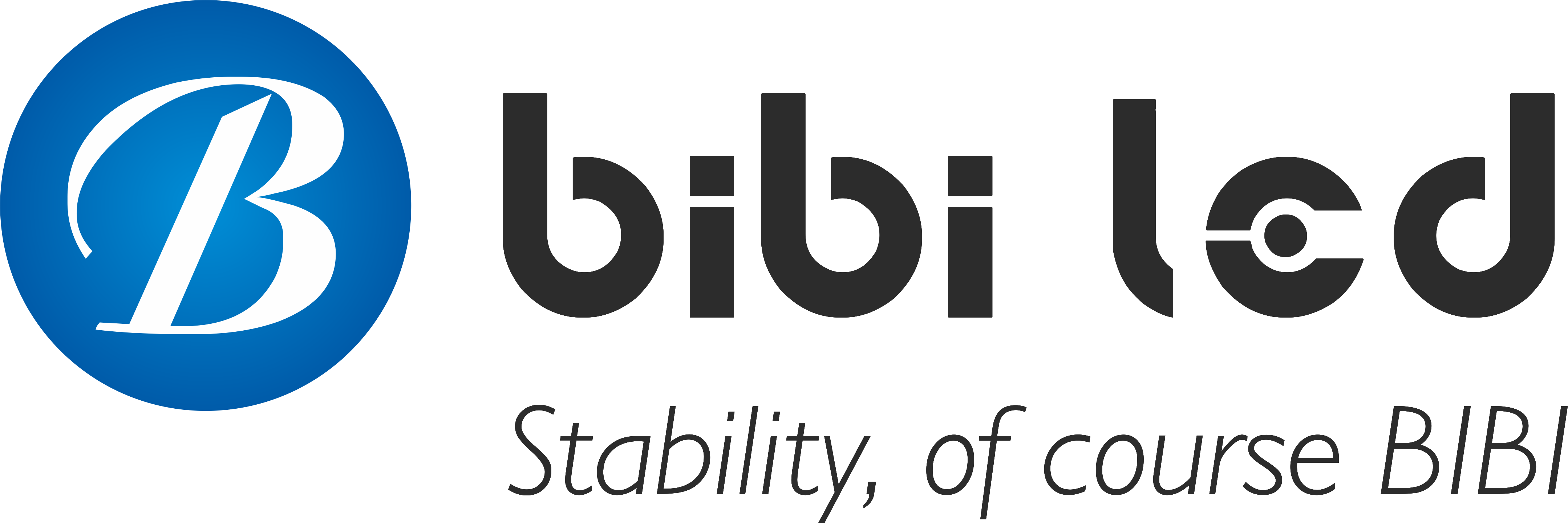Introduction
Today, university auditoriums are not only the hubs for academic lectures and events, but also a platform showcasing the university’s modernity.
More and more universities are upgrading from traditional projection equipment to Écrans LED, providing students and faculty with a clearer, more efficient learning and activity experience.
So why are universities making this decision? What kind of changes can LED screens bring?
Table des matières
1. Why are universities upgrading their auditoriums to LED screens?
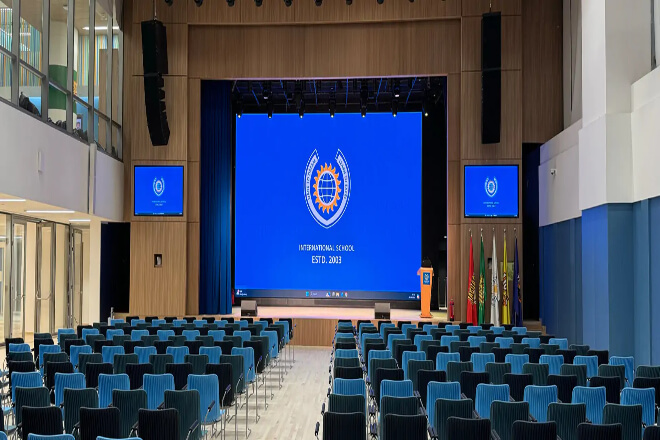
1) Improved Visual Experience
As we all know, traditional projectors have a major problem: the content on the screen becomes blurry in bright daylight.
Imagine listening to a lecture and the projected image is blurry, with the speaker’s PowerPoint completely obscured by fog.
Doesn’t it feel like stepping into a sci-fi movie? LED screens, however, don’t have to worry about these issues!
Whether it’s a bright sunny day or a dimly lit night, LED screens maintain ultra-clear, vibrant images.
No matter where you sit, you can clearly see every detail, giving you the most realistic and immersive visual experience.
2) Versatility
Traditional projectors are a one-trick pony—they can only display PowerPoint presentations and videos. But LED displays offer so much more!
They can display videos, images, text, real-time data, and even multiple formats simultaneously, truly embodying versatility.
For example, during a lecture, you can play a vivid brand video or display live scores and audience interaction during a sports event. Switching content anytime, anywhere offers incredible flexibility.
3) Flexible Content Updates
One of the biggest advantages of LED displays is their ability to adapt content to changing event themes in real time. You no longer have to manually adjust the projector or change slides, as before.
As the theme changes, the content on the screen instantly adapts, transforming into a dedicated display dedicated to the event. At the end of a presentation, the screen instantly switches to a concert background.
At the end of a meeting, the screen transforms into a preview of the evening’s exciting event. Who wouldn’t love this efficient and hassle-free design?
4) Save Space and Equipment
Imagine if your auditorium is equipped with an LED screen. Projectors, screens, speakers, and other equipment can all be reduced!
Previously, a multitude of equipment was piled up, taking up space and wasting time.
Now, a single large screen solves all these problems. The integrated design of LED screens significantly improves space utilisation.
Whether hosting a small lecture or a large celebration, unnecessary equipment, set design, and staff management can be eliminated, making the entire event flow more smoothly.
5) Low Long-Term Costs
Although the initial investment in an LED screen may seem a bit daunting, in the long run, its low maintenance costs and long lifespan make it highly cost-effective.
Traditional projectors require frequent lamp replacements and require tedious maintenance.
LED screens, on the other hand, eliminate this hassle, have a longer lifespan, require virtually no replacement parts, and are much simpler to maintain.
Schools can save significant time and budget, making it a truly worthwhile investment in the long run!
2. How can LED screens enhance the diverse functions of university auditoriums?
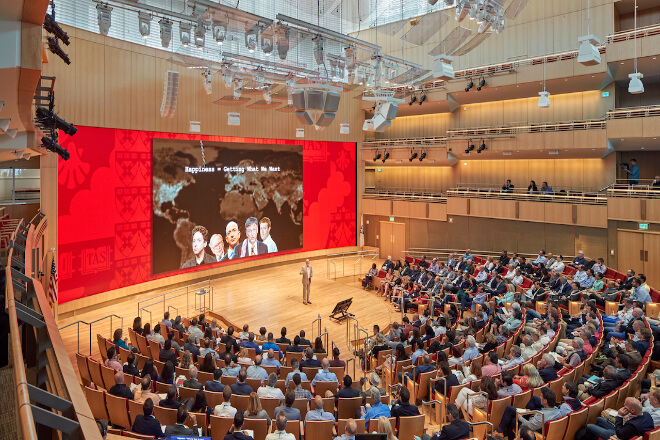
1) Lectures and Academic Conferences
Imagine a professor at an academic conference presenting a PowerPoint presentation with crisp charts and clear data analysis, all displayed clearly on a large screen.
This is no longer a dream; it’s a reality made possible by LED displays! Traditional projectors can present PowerPoint presentations.
But they are often limited by luminosité and clarity, often resulting in blurry images, especially in brightly lit environments.
LED displays, on the other hand, provide crisp, vibrant images, allowing every detail of the presentation to be accurately presented, regardless of glare.
Whether it’s complex academic data or beautiful charts, LED displays ensure every point of information is clearly visible to the audience.
This facilitates smooth interaction between professors and audiences, significantly enhancing the effectiveness of presentations.

2) Large-Scale Events and Cultural Performances
If you’ve ever witnessed a grand cultural performance in a university auditorium, you know how crucial the atmosphere is.
LED displays are the “secret weapon” that enhances this atmosphere. From lighting to dynamic images, LED displays seamlessly blend to create an immersive experience.
Especially for events like evening parties and organiser plays, LED screens can not only display video backgrounds, but also play live footage and even use animation to enhance the visual impact.
Just like a spectacular evening party, the beautiful images and background videos that flash across the screen always immerse the audience more deeply and bring the atmosphere to life.
Imagine the actors on stage interacting with the images on the big screen—the audience will hardly blink.
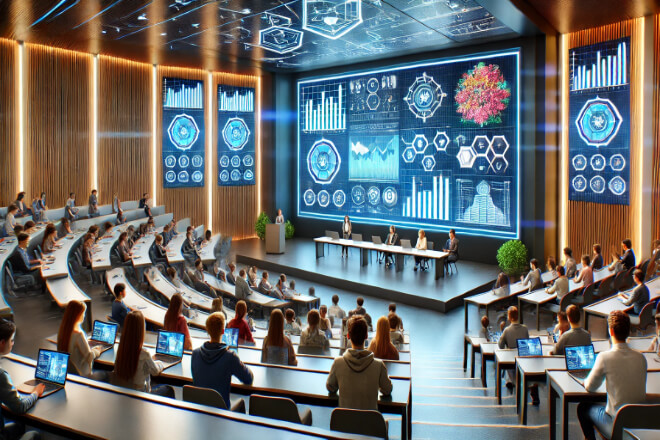
3) Remote Learning and Interaction
The rise of remote learning has expanded the functions of university auditoriums beyond in-person events.
Now, LED screens enable video conferencing and remote interaction, helping professors and students transcend physical distance and enjoy broader communication and interaction.
Imagine a lecture where a professor and an expert in another city interact in real time via an LED screen, and students in the classroom can also participate in the discussion.
This “trans-time and space” learning experience not only improves teaching effectiveness but also provides students with a richer range of learning resources.
No longer worry about being limited to attending lectures on campus; remote classes are waiting for you right in front of the LED screen.
4) Cultural Events and Des expositions
LED displays can also serve as a window for universities to showcase their culture, history, and academic achievements. Want to teach freshmen about the university’s history?
LED displays can vividly and intuitively showcase highlights and major achievements from its founding to the present day.
By combining images, text, and video, LED displays enrich and deepen the university’s cultural heritage.
For example, the university’s founding history, important scientific research achievements.
Or participation in global competitions can all be vividly presented on LED screens, breaking away from traditional, single-minded promotional methods and making cultural displays more interesting and engaging.
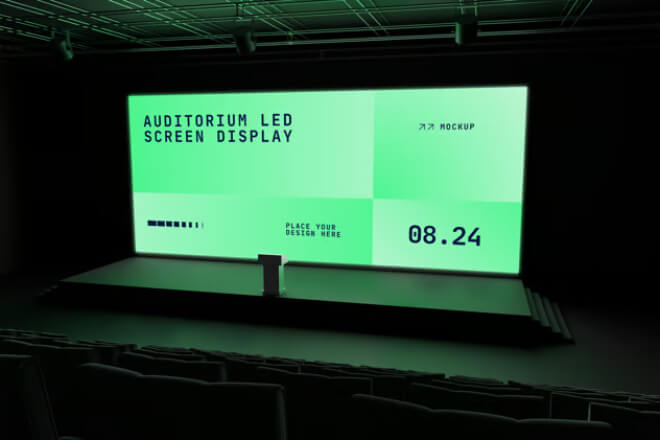
5) On-Campus Announcements and Advertising
LED displays can serve as both on-campus announcements and advertisements for more than just academic events. Do you often miss campus events?
LED displays can broadcast real-time campus announcements and event previews, ensuring you never miss any exciting on-campus events.
Additionally, on-campus sponsor advertisements can be displayed without disrupting regular activities, generating additional revenue for the university.
For example, an interesting lecture, an upcoming cultural festival, or a discount event can be communicated to all students immediately via LED screens, creating a concise and efficient experience.
3. Innovative Applications of LED Displays in University Auditoriums
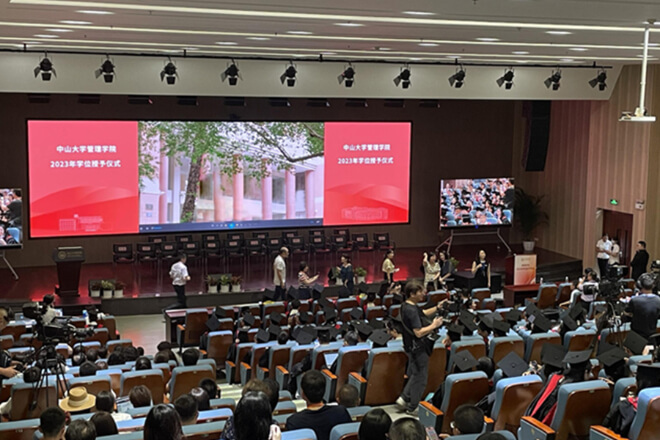
If you’ve ever attended a large-scale event or performance in a university auditorium, you know that the design of the organiser backdrop is crucial.
Large LED displays are an indispensable part of modern stage design. They can display high-definition dynamic images, creating a stunning visual effect as the main stage backdrop.
More than just a simple backdrop, they can switch between different images, videos, and graphics in real time as the content of the event changes, helping to convey emotion and enhance the audience’s sense of immersion.
For example, at graduation ceremonies, LED displays can play university history, review students’ university life, or showcase highlights from graduates.
During performances, they can become a dynamic canvas that complements the plot, making the stage more lively and engaging.
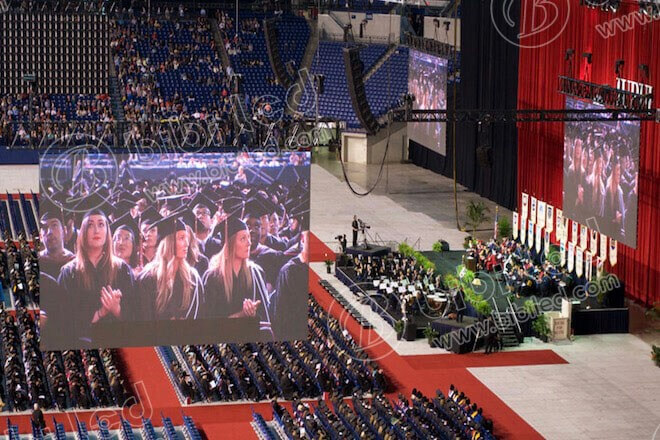
2) Side and Auxiliary LED Screens
In addition to the main screen, university auditoriums are often equipped with side and auxiliary screens.
These screens play a significant role, displaying subtitles, translations, voting results, and even real-time audience feedback.
For example, during a lecture, a professor can use the side screens to simultaneously display lecture notes and key points, helping students better understand the content.
In academic conferences, side screens can display real-time voting results or Q&A sessions, increasing interactivity.
Sometimes, side screens are also used to display audience feedback or messages, making participants feel more connected to the event and enhancing interactivity and engagement.
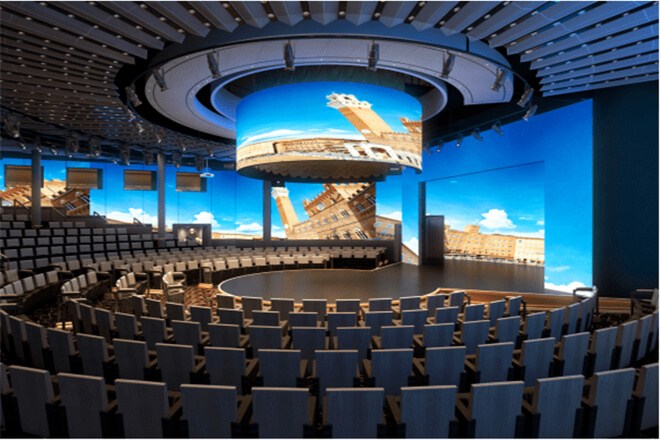
3) Curved or curved LED displays
Every university auditorium has its own unique design, and curved or curved displays are innovative forms tailored to these unique designs.
They transcend the limitations of traditional flat screens and adapt to the auditorium’s spatial layout. Curved displays offer a wider audience viewing angle.
They are particularly well-suited for venues with irregular layouts or widely spaced seating, ensuring clear viewing from all angles.
This curved design not only offers a modern aesthetic but also creates a stronger visual impact, adding a futuristic feel to the auditorium space.
For example, certain cultural events or stage plays may utilise curved screens to create a more immersive visual experience, breaking the monotony of a flat display.
4. Key Design Considerations for Upgrading University Auditoriums to LED Displays
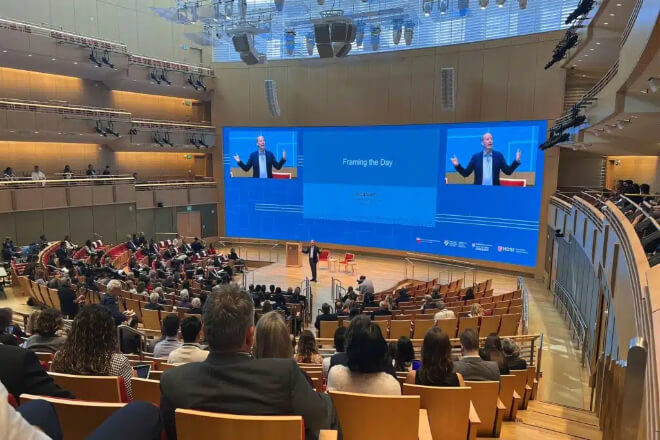
To truly maximise the benefits of LED displays, simply choosing a beautiful screen isn’t enough.
It also requires careful design and configuration tailored to the auditorium’s specific needs.
First and foremost, screen size and résolution are crucial factors in determining the display quality.
The size of the auditorium and the audience’s viewing distance directly influence screen selection.
For large auditoriums, the screen size needs to be large enough to ensure that even those sitting in the last row can clearly see the content on the screen.
At the same time, the resolution also needs to consider clarity, ensuring that even on a large screen, the content remains crisp and detailed.
Simply put, if you want viewers who are further away from the screen not to experience blurriness, then the screen size and resolution must be appropriately selected based on the auditorium’s size.
It’s like watching a blockbuster movie: the farther away, the larger the screen and the higher the image quality.
University auditoriums typically experience significant light fluctuations, from bright daylight to dim nighttime.
Par conséquent, la luminosité and anti-reflection design of the LED display are particularly important.
The screen’s brightness must be high enough to handle brightly lit environments. However, excessive brightness in low-light evenings can affect the audience’s viewing experience.
Therefore, the screen needs to be able to automatically adjust brightness to ensure optimal display quality at all times.
Anti-reflective design is also crucial, especially in environments with windows or bright lighting, to prevent glare from affecting the displayed content.
This ensures that LED screens provide clear, vibrant images day and night.
When upgrading to an LED screen, compatibility with the auditorium’s existing audio, lighting, and control systems is also a crucial design consideration.
The LED screen needs to seamlessly integrate with these devices, ensuring audio and video synchronisation and coordinated lighting and visual effects.
Incompatibility between the audio, lighting, and LED screens significantly diminishes the effectiveness of the event.
During the design process, ensure that all equipment can be controlled through an integrated system to simplify operation and minimise the possibility of device conflicts.
Imagine an event where lighting effects seamlessly coordinate with music and visuals. This immersive and impactful experience will surely be remembered by the audience.
Auditorium LED displays often need to operate for extended periods of time, making their reliability crucial.
They must maintain stable operation under intense use to prevent equipment failures from disrupting the progress of events.
Furthermore, auditorium environments vary widely, so the screens must be shockproof and dustproof, especially in high-traffic areas like schools, ensuring they can operate normally in these changing environments.
Screen safety is equally crucial, especially with frequent use. LED screens must incorporate adequate safety measures to prevent overheating and electrical failures.
Although LED displays are highly durable, all equipment requires maintenance and replacement. Therefore, ease of maintenance should be factored into the design.
A good design makes maintenance easier and faster. For example, a modular design allows for the replacement or repair of specific components without disassembling the entire screen, saving time and reducing downtime.
The system should also include remote monitoring and management capabilities to monitor device status at all times, proactively identify and address issues.
And avoid disruptions to activities due to equipment failures and reduce unnecessary repair costs.
5. The Long-Term Returns of LED Displays in University Auditoriums
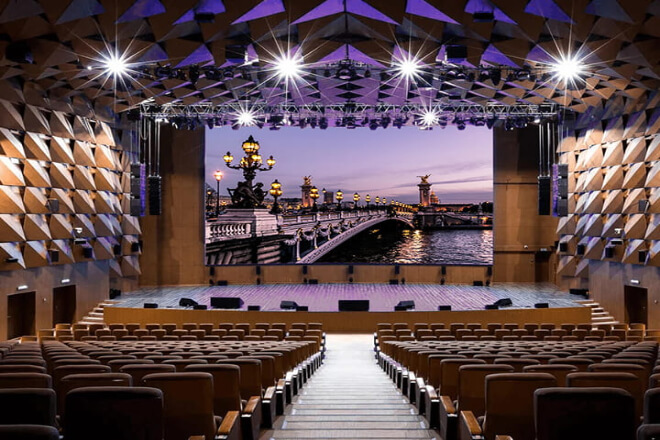
The introduction of LED displays not only brings immediate visual impact and functional improvements to university auditoriums but also provides sustainable, long-term returns for institutions.
1) Improving Teaching Efficiency and Learning Experience
University auditoriums often host important teaching, seminars, and other academic activities.
Traditional projection equipment often suffers from issues such as insufficient résolution and poor light adaptability, which directly impact the student learning experience.
LED displays, with their high definition and luminosité, provide clearer images and more vivid presentations, helping students better understand complex content.
Especially when it comes to large-scale data analysis, charts, and multimedia content, LED displays can easily display every detail, reducing the difficulty students face due to blurry or unclear images.
Whether students are far away or scholars sitting in the corner, every detail can be easily accessed, significantly enhancing classroom interaction and engagement.
2) Reducing Maintenance Costs for Traditional Equipment
Traditional projection equipment and screens typically require regular replacement and maintenance, and replacement of projection lamps is relatively expensive.
In contrast, LED displays have significantly lower maintenance costs than traditional equipment.
LED screens have a long lifespan and are easy to maintain, requiring no frequent replacement parts. This reduces maintenance costs and the frequency of equipment replacement.
Universities can reinvest the savings in maintenance costs in other areas, such as improving teaching resources and enhancing the classroom experience, making LED screens a highly effective investment that will yield significant long-term savings.
3) Enhance the school’s image
LED screens are more than just teaching tools; they can also enhance a school’s sense of modernity and technology.
With the continuous advancement of technology, students and external partners have higher expectations for a school’s modernity.
Using high-end LED screens for teaching and event presentations not only enhances the effectiveness of activities but also indirectly improves the school’s overall image.
Through this modern equipment, schools showcase their cutting-edge technological applications, further establishing their innovation and leadership in education, and leaving a lasting impression on students, faculty, and visiting external organisations.
4) Attract more events and external collaborations
The powerful display capabilities of LED screens are not only suitable for daily teaching but can also be used to host large-scale events, lectures, conferences, and more.
Due to its high-definition display and dynamic content presentation capabilities, many external organisations and businesses may be interested in renting university auditoriums for exhibitions, business promotions, cultural events, and more.
This high-quality display attracts more external partnerships and events, generating additional revenue and exposure for the university.
Furthermore, the university can use these facilities to host more international academic exchanges or professional seminars, enhancing the university’s social influence, partnership opportunities, and strengthening connections with the industry.
5) Advertising and Promotional Revenue
The university auditorium’s LED display screen serves more than just academic and event functions; it also serves as an advertising platform.
Schools can generate additional revenue by displaying commercials or information about on-campus events.
For example, schools can partner with local businesses or sponsors to broadcast advertising content without disrupting classes, creating new revenue streams.
Furthermore, LED screens can also display important internal notices, upcoming events, and course information, ensuring all students and faculty are kept up to date with campus developments.
This information display method not only improves campus communication efficiency but also creates additional brand value and potential revenue for the university.
6. Conclusion
In short, the use of LED displays in university auditoriums not only improves teaching quality but also brings more creativity and possibilities to various activities.
Whether it’s academic lectures, theatrical performances, or distance learning, LED displays provide a versatile platform for universities, helping them save resources, enhance their image, and attract more external collaborations and events.
Finally, for more information about LED displays, veuillez nous contacter.
